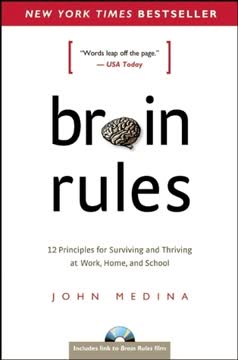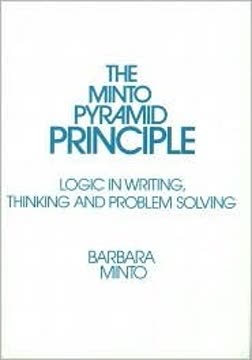Key Takeaways
1. Transformative facilitation breaks through constraints by cycling between vertical and horizontal approaches
Transformative facilitation cycles between two poles to get the best of both and avoid the worst.
Vertical vs. horizontal. Vertical facilitation focuses on the good of the whole group, relying on hierarchy and expertise to push change from the top down. It provides coordination and cohesion but can lead to rigidity and domination. Horizontal facilitation emphasizes individual autonomy and equality, allowing each participant to choose their own actions. This provides variety but can result in fragmentation and gridlock.
Cycling between approaches. Transformative facilitation transcends these limitations by cycling fluidly between vertical and horizontal moves. This allows groups to harness the strengths of both approaches while avoiding their downsides. The facilitator makes five pairs of moves:
- Advocating and inquiring
- Concluding and advancing
- Mapping and discovering
- Directing and accompanying
- Standing outside and inside
By cycling between these moves, the facilitator helps the group stay on a middle path that enables breakthrough and transformation.
2. Facilitators must pay attention and adapt to enable breakthrough
The facilitator knows what move to make next by paying attention.
Attentiveness is key. To cycle effectively between vertical and horizontal moves, facilitators must be fully present and attentive to what is happening in the group moment-to-moment. This requires overcoming both external distractions (e.g. phones) and internal ones (e.g. ego, insecurity). Facilitators must continually bring their attention back to the present, just as in meditation.
Five inner shifts. In addition to the outer moves, transformative facilitation involves five inner shifts that allow facilitators to cycle fluidly:
- Opening
- Discerning
- Adapting
- Serving
- Partnering
These shifts enable the facilitator to sense what move is needed next. With practice, master facilitators can make these shifts unconsciously and fluidly, like an experienced sailor adjusting to changing winds.
3. Removing obstacles to contribution, connection, and equity is key to transformative facilitation
Transformative facilitation enables progress by removing the obstacles to love, power, and justice.
Three key ingredients. Transformative facilitation focuses on removing obstacles to:
- Contribution - allowing all participants to offer their diverse ideas and resources
- Connection - enabling participants to build relationships and understanding across differences
- Equity - ensuring fair and inclusive participation
Creating breakthrough. By systematically removing structural obstacles to these three elements, transformative facilitation enables groups to break through from stuckness to flow. This allows them to collaborate effectively even across deep divides.
Examples of removing obstacles:
- Using rounds so all voices are heard
- Mixing up small groups to build new connections
- Creating ground rules for respectful dialogue
- Using physical and online spaces flexibly
4. Cycling between advocating and inquiring allows groups to see their situation clearly
The facilitator moves back and forth between advocating for a particular process—forthrightly presenting their perspective on what is happening in the group and what the group needs to do about this—and inquiring as to the perspectives of the participants on these matters.
Balancing perspectives. Advocating involves confidently putting forward one's view, while inquiring means openly exploring others' perspectives. Cycling between these allows groups to harness both expert knowledge and diverse viewpoints.
Opening up. The key inner shift is "opening" - being willing to consider multiple perspectives. Techniques for opening up include:
- Suspending judgment and "hanging" thoughts in front of oneself
- Redirecting attention to see from others' viewpoints
- Letting go of preconceived ideas to allow new insights to emerge
By cycling between advocating and inquiring, groups can develop a clearer, shared understanding of their situation and what needs to be done.
5. Balancing concluding and advancing helps groups define success and make progress
Sometimes, as in the Food Lab workshop, a group finds it more important to advance than to agree. Other times the opposite is true, and an agreement is needed.
Discerning timing. The key inner shift is discerning - knowing when to push for agreement and when to keep moving without full consensus. Effective facilitators sense when the group needs to slow down to align, and when forward momentum is more important.
Iterative process. Groups often cycle through:
- Diverging - gathering diverse ideas and perspectives
- Emerging - allowing new possibilities to arise
- Converging - drawing conclusions and making agreements
This process repeats at different scales throughout a collaboration. By balancing concluding and advancing, groups can make steady progress while remaining open to new insights and possibilities.
6. Mapping and discovering enables groups to find their way forward
Walker, there is no path. The path is made by walking.
Adapting is crucial. The key inner shift is adapting - being willing to adjust plans based on what emerges. While planning is valuable, facilitators and groups must be ready to pivot when things unfold differently than expected.
Experimenting and learning. Effective progress often involves:
- Trying small experiments before big ones
- Getting rapid feedback and adjusting quickly
- Being willing to fail and learn
- Maintaining a playful, creative spirit
By cycling between mapping out plans and discovering through action, groups can navigate complex, unpredictable situations more effectively.
7. Directing and accompanying allows facilitators to coordinate group actions
A facilitator isn't only an earnest, energetic professional in a windowless conference room or in a window in a video conference. It isn't only someone who runs training or strategic planning exercises. It isn't only a referee or timekeeper. It is anyone who helps people work together to transform their situation.
Balancing coordination and autonomy. Directing involves providing clear guidance and structure, while accompanying means supporting participants as they take their own initiative. Cycling between these allows facilitators to enable coordinated action without stifling individual agency.
Serving is key. The inner shift of serving - focusing on genuinely supporting the group's work - allows facilitators to direct without dominating and accompany without abdicating responsibility. When participants trust the facilitator's intentions, they are more willing to follow direction or take initiative as needed.
8. Standing both outside and inside the situation enhances facilitator effectiveness
To emphasize the basics: transformative facilitation is facilitated by a facilitator.
Dual perspective. Standing outside allows facilitators to see the big picture objectively. Standing inside acknowledges their role in and responsibility for the situation. Cycling between these perspectives enhances understanding and influence.
Partnering as foundation. The key inner shift is partnering - seeing oneself as both apart from and a part of the group and situation. This allows facilitators to contribute their expertise while remaining open to learning from participants.
Benefits of this dual stance:
- Provides both distance and empathy
- Allows both analysis and engagement
- Enables both guidance and participation
9. Love, power, and justice are fundamental drives that transformative facilitation engages
Transformative facilitation enables the threefold transformative potential of love, power, and justice.
Three key drives. Transformative facilitation engages:
- Love - the drive toward unity and connection
- Power - the drive toward self-realization and contribution
- Justice - the structure enabling equitable love and power
Balancing all three. Effective facilitation requires engaging all of these drives in creative tension. Overemphasizing any one at the expense of the others limits transformation.
Creating a better world. By removing obstacles to love, power, and justice, transformative facilitation offers a way to escape imposition and fragmentation. It provides a path for diverse groups to move forward together, creating positive change in organizations and societies.
Last updated:
FAQ
What's "Facilitating Breakthrough" by Adam Kahane about?
- Purpose of the book: "Facilitating Breakthrough" is about helping people collaborate to transform problematic situations by removing obstacles, bridging differences, and moving forward together.
- Focus on facilitation: The book introduces transformative facilitation, an approach that cycles between vertical and horizontal facilitation to enable groups to achieve breakthroughs.
- Practical guidance: It provides a framework for facilitators to help groups work through five basic collaboration questions, using ten specific moves and five inner shifts.
- Broader implications: The book also explores how transformative facilitation can contribute to creating a more just, equitable, and sustainable world.
Why should I read "Facilitating Breakthrough"?
- Learn transformative facilitation: The book offers a unique approach to facilitation that can help you effectively manage complex and conflictual situations.
- Improve collaboration skills: It provides practical tools and strategies for facilitating collaboration across diverse groups, which is valuable in both professional and personal contexts.
- Address systemic challenges: The insights can be applied to tackle larger societal issues, making it relevant for those interested in social change.
- Enhance personal growth: By understanding the dynamics of love, power, and justice, you can develop a deeper awareness of your role in collaborative efforts.
What are the key takeaways of "Facilitating Breakthrough"?
- Transformative facilitation: This approach involves cycling between vertical and horizontal facilitation to remove obstacles and enable breakthroughs.
- Five collaboration questions: Facilitators should help groups address how they see their situation, define success, plan their route, decide roles, and understand their responsibilities.
- Ten moves and five shifts: The book outlines specific moves and inner shifts facilitators can use to guide groups effectively.
- Love, power, and justice: These are fundamental drives that need to be balanced to achieve transformative change.
How does Adam Kahane define transformative facilitation?
- Cycling between approaches: Transformative facilitation involves alternating between vertical and horizontal facilitation to harness the strengths of both.
- Removing obstacles: The focus is on removing structural barriers to contribution, connection, and equity within groups.
- Dynamic balance: Facilitators must maintain a dynamic balance, similar to cycling, to keep the group moving forward.
- Enabling breakthroughs: The ultimate goal is to enable groups to achieve breakthroughs in complex and conflictual situations.
What are the five basic collaboration questions in "Facilitating Breakthrough"?
- Understanding the situation: How do we see our situation? This involves advocating and inquiring to gain a comprehensive understanding.
- Defining success: How do we define success? Facilitators help groups cycle between concluding and advancing.
- Planning the route: How will we get from here to there? This involves mapping and discovering the path forward.
- Deciding roles: How do we decide who does what? Facilitators guide groups in directing and accompanying.
- Understanding responsibilities: How do we understand our role? This involves standing outside and inside the situation.
What are the ten moves and five shifts in "Facilitating Breakthrough"?
- Ten moves: These include advocating, inquiring, concluding, advancing, mapping, discovering, directing, accompanying, standing outside, and standing inside.
- Five shifts: Facilitators need to make inner shifts such as opening, discerning, adapting, serving, and partnering to effectively guide groups.
- Purpose of moves and shifts: They help facilitators cycle between vertical and horizontal facilitation to address the five collaboration questions.
- Dynamic application: Facilitators must apply these moves and shifts fluidly and as needed to maintain group progress.
How does "Facilitating Breakthrough" address love, power, and justice?
- Three fundamental drives: Love, power, and justice are essential for transformative facilitation and must be balanced.
- Love: Defined as the drive toward unity, it manifests as connection among participants.
- Power: Defined as the drive toward self-realization, it manifests as contribution to the collaborative effort.
- Justice: Provides the structure that enables love and power, ensuring equity within the group and in the situation.
What are some practical examples of transformative facilitation in action?
- Colombia project: Facilitators helped diverse leaders collaborate to address regional challenges post-conflict, focusing on removing obstacles to contribution, connection, and equity.
- Education Lab in Mexico: Initiative teams worked on systemic reforms, cycling between mapping and discovering to adapt to challenges.
- Guatemala peace process: Participants connected deeply through storytelling, enabling them to collaborate on national initiatives post-conflict.
- Haiti project: Despite political unrest, facilitators guided a diverse group to collaborate on national transformation efforts.
What are the best quotes from "Facilitating Breakthrough" and what do they mean?
- "You are removing the obstacles to the expression of the mystery!" This quote highlights the essence of transformative facilitation: enabling the natural flow of collaboration by removing barriers.
- "Pay attention; the rest is interpretation. Go practice." This emphasizes the importance of attentiveness in facilitation, suggesting that practice and presence are key to mastering the approach.
- "Power at its best is love implementing the demands of justice." This quote underscores the need to balance love, power, and justice to achieve transformative change.
How can I apply the concepts from "Facilitating Breakthrough" in my own work?
- Assess your situation: Identify if your situation is problematic and if collaboration is the best approach to address it.
- Engage diverse stakeholders: Consider who needs to be involved in the collaboration and how to enroll them.
- Use the five questions: Guide your group through the five collaboration questions to structure your facilitation efforts.
- Practice the moves and shifts: Develop fluency in the ten moves and five shifts to effectively facilitate group progress.
What challenges might I face when implementing transformative facilitation?
- Balancing drives: Maintaining a balance between love, power, and justice can be challenging, especially under stress.
- Dynamic application: Applying the ten moves and five shifts fluidly requires practice and attentiveness.
- Resistance to change: Participants may resist new approaches, requiring facilitators to be adaptable and patient.
- Complexity of situations: Facilitators must navigate complex and conflictual situations, often with limited control.
How does "Facilitating Breakthrough" contribute to creating a better world?
- Enabling collaboration: The book provides tools and strategies to help diverse groups work together effectively on complex challenges.
- Addressing systemic issues: By focusing on love, power, and justice, transformative facilitation can contribute to systemic change.
- Promoting equity: The approach emphasizes removing obstacles to equitable contribution and connection, fostering inclusivity.
- Inspiring action: By demonstrating the possibility of moving forward together, the book encourages individuals and groups to take action for positive change.
Review Summary
Facilitating Breakthrough receives high praise for its insightful approach to transformative facilitation. Readers appreciate Kahane's clear framework for addressing complex challenges, bridging differences, and fostering collaboration. The book is lauded for its thought-provoking content, practical tools, and real-world examples. Reviewers find it valuable for facilitators, leaders, and anyone involved in group dynamics. While some note the density of information, most consider it a powerful resource for creating positive change and moving forward together in diverse settings.
Similar Books










Download PDF
Download EPUB
.epub digital book format is ideal for reading ebooks on phones, tablets, and e-readers.






